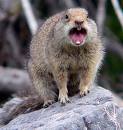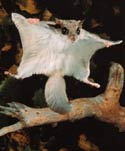|
|
 |
 Squirrels are rodents,
the same as rats. They can carry the SAME diseases (plus a few) and they are not afraid of people (wild rats are). At certain
times of the year, you can train a wild (suburban) squirrel to take a peanut from your hand in less than three days. Just
remember, however, that the cute fuzzy tail is the only difference. The teeth of all rodents are like our fingernails - they
are always growing. So they must chew on something all the time. And for some reason, gravid female squirrels favor chewing
on metal. Pipes, wires, nails, anything they find. If they do this inside your house, this will cause you huge problems later
on. Squirrels can climb a vertical brick face. They can also scale a vertical aluminum-sided house just as easily. They can
scuttle over or underhanded, on wires, as easily as you can walk, and they can float, over ninety feet to the ground, absolutely
unhurt. Squirrels are clever, persistent animals, and one of the very few animals that have increased their populations in
the presence of man. Squirrels are omnivores and will eat any kind of food you can think of, and some that you can’t.
That means they will scavenge from your open garage, from your trash, fruit and nut trees, and your garden. Keep them out
of your trashcans. You probably won’t think so for long if you’ve got ‘um in your attic (walls, house, etc.). I’ll
skip over all the harm they can do and just say the longer they’re there the harder they will be to get rid of, and
there are some horror stories. Forget about poisons, repellants (moth balls are a myth), etc. Rat poison will just have them rotting and smelling in your walls anyway. Don’t board
up their entry to shut ‘um in or out (they just gnaw new holes). None of these methods are good enough
 Squirrels are typically
not important vectors of disease. But, squirrels do have teeth and will bite!!! I don't think, but I might be wrong, there's hasn't been any
documented cases of rabies transmission from squirrels. But like all animals, squirrels can carry parasites, they leave behind
excrement, and they can leave both in your attic. Squirrel droppings, like pretty much any wildlife dropping, are associated
with Leptospirosis and Salmonella. Therefore should be removed and sanitized properly.
|
 |
How Do They get Inside
Squirrels entered the house right through the soffits at roof level, then into the attic, and began removing insulation
from the walls. They can fit through anything they can get their head through. Once inside, their curiosity drives them to
explore. If you don’t have a chimney trap/guard it’s an invitation. As your house ages, this weathering provides
the opportunity for squirrels to discover a damaged piece of trim, allowing them partial entrance. They’ll finish the
job, quite easily, in a half hour or so, if they want to. And they don’t really need your attic .An exposed soffit will do just as well. If it’s a
soffit, you might not hear them, and they could be in there for months. They will make their home in any small area, but will
investigate whatever they can. And they can fit through anything they can get their head through. Once inside, their innate
curiosity will force them to explore their new surroundings.
|
 |
|
|
|
 |
|
HOW TO REMOVE THEM
Once you remove the squirrels
you have to close their entry points. You may not want to remove them before locating their entries so you can watch their
activity to locate their holes. Entry points are often in trim and at the bottom corners of roofs near the ends of soffits.
Examine trim and soffits all around. If they find a small opening in a piece of trim they can gnaw it into an entry hole in
minutes. Check aluminum roof ventilators. They can quickly chew through aluminum screening. Mothballs aren’t even that
good for moths, much less squirrels. Not too long ago, we dismantled a recently active nest (in someone’s attic) that
was over three feet high and laced with hundreds of mothballs. Didn’t bother the squirrels at all. After all that, you
can just forget the mothballs, loud rock music, basil, mint, garlic, marigolds, ammonia, bleach, borax or boric acid, and
catnip. Also forget fox, cat, wolf, coyote, bear, dinosaur or human urine or plastic fake owls. There is also no device, electronic,
magnetic, sonic, stroboscopic, or any combination of these, that will consistently deter these critters.
 |
 |
|
|
|
|
THE CLEAN UP PROCESS
How to clean up after those
%#*&#@ squirrels? That’s a tough question. It kind of depends on how sensitive you are. And how long they’ve
been in there. And how “dirty” it is. If they’ve been there a long time, and if it’s REAL dirty, or
if you just want to be anal about the whole thing, you would clean up the poop, (most will come up with a dust pan) and then
you could spray the area(s) with a bleach mixture, (DON’T EVER MIX BLEACH WITH AMMONIA) let it dry and then, if you
prefer, you could PAINT the areas with an alkyd-based primer. If the insulation
is permeated with droppings, you should replace the insulation. It is extremely difficult to remove the poop from insulation. You’re better off
removing and replacing, if you’re going to do it at all. The squirrels will use several places to “use the bathroom.”
After awhile, this can be many places and you may notice a distinct odor of urine, again it will depend on your own sensibilities.
There are plenty of structures that AREN’T cleaned up and don’t seem to have a problem. When I do squirrel jobs, it depends on whether replacement of the insulation is necessary, and in most cases, it isn’t
really needed unless the structure has been inhabited for years.
If you have a wildlife problem,
it best be handled by a professional firm, such as ourselves. Then, and only
then, can you have peace of mind that that neither yourself or family member
will be bitten or injured and if required, a biological cleanup will be done
properly if needed.
Please Visit Our NEW Service Bees & Hives
Please Click Here To Visit Our Other Web Sites WildlifeSolution.net
Return To Home
Created, Designed & Maintain by Big Buck
google-site-verification: google14c50c699a969ca5.html
|
|
|
 |

